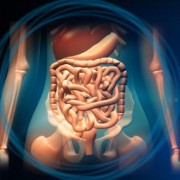 Photo: Getty Images
Photo: Getty Images
Intestine facts
The intestine is a crucial part of the digestive system. Digestion begins in the mouth and stomach and is finished in the intestines. The upper part of the intestine, which is known as the small intestine, is a narrow, muscular tube that is about 20 feet long. It is coiled in the abdomen where it receives food from the stomach and finishes the process of absorbing vitamins and other nutrients. The lower part of the intestine, which is called the large intestine, is a wider tube that is about seven feet long and connects the small intestine to the anus. The large intestine absorbs excess water from the food and returns it to the blood stream. It also carries the waste products from the digestive process to the anus where they are eliminated from the body.
Why people need intestine transplants
If the intestines are not working correctly, you may experience dehydration and diarrhea as too much water is eliminated from your body. Some short-term illnesses like the flu or food poisoning can cause temporary diarrhea as the body eliminates the cause of the sickness. When the intestines begin to fail, these symptoms can become permanent, leading to on-going diarrhea and dehydration as well as muscle loss, poor growth, weight loss, fatigue, and frequent infections.
In some cases, the intestines are damaged in an accident or become twisted during an abdominal surgery for another condition. In these cases, doctors may need to remove some or all of the intestine. In other cases, disease may damage the intestine or prevent it from working correctly. If too much small intestine is removed or if it is not able to function, the body will not be able to absorb enough nutrients.
The need for intestine donations
If food cannot be digested, the patient may have to stop eating normal food and be fed nutrient fluid directly into the bloodstream. While this can provide nutrition, it can also lead to other complications with long-term use including bone disorders, infections, and liver failure. In addition, if the large intestine and rectum have to be removed, the patient will not have normal bowel function. The remaining portion of intestine will need to be attached to the wall of the abdomen so waste products can empty from the intestine into a pouch on the outside of the body known as an ostomy bag.
So far in 2010, 115 people have received intestine transplants, while another 262 people are currently on the waiting list hoping to receive a matching intestine. Most intestine donations come from people who have died but who chose to share the gift of their organs with others. In rare cases, intestines can come from living donors who provide a portion of their intestine for transplant.
Intestine donors give quality of life
For patients with failing intestines, or who do not have enough intestine, an intestine donation can make it possible to enjoy the flavors and textures of normal food again. To find out more about how you can be an organ donor, visit the Donate Life America website.
Sources:
Intestinal Transplant Association
University of California San Francisco Medical Center
Transplant Living
Organ Procurement and Transplantation Network





Add a CommentComments
There are no comments yet. Be the first one and get the conversation started!